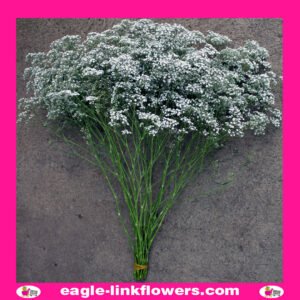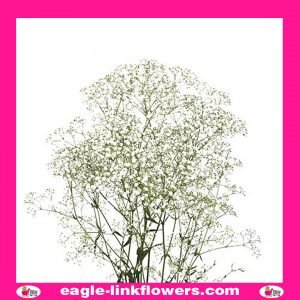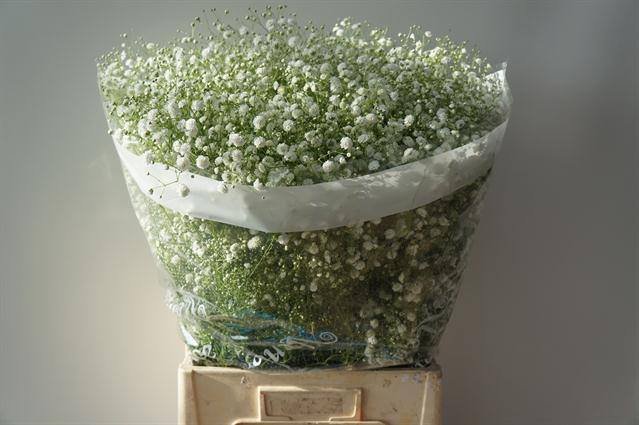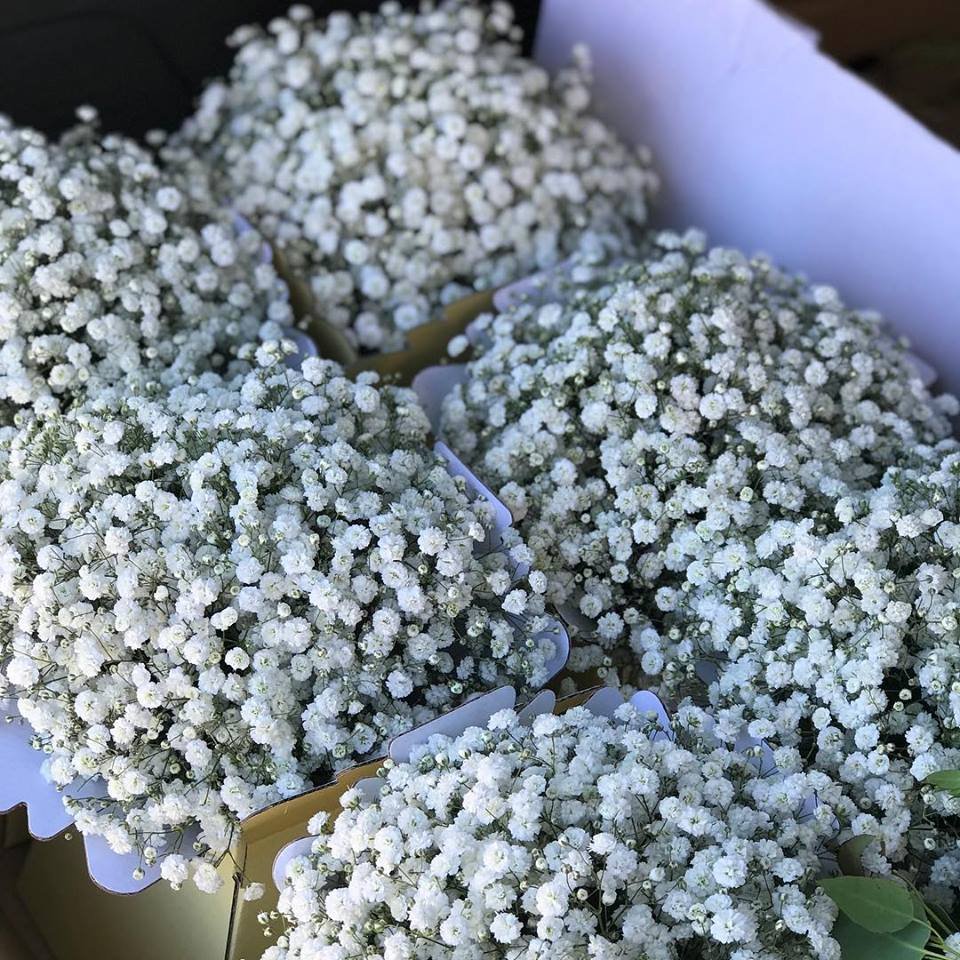
Baby’s breath (Gypsophila) can be used for so many different kinds of floral arrangements – mason jar centerpieces, pew arrangements, flower crowns, bouquets, bad vases, boutonnieres, etc. Once the pieces from the one stem of baby’s breath is bunched together, you can see that a little goes a long way. That one stem could be enough for a mason jar centerpiece. If you want a more full arrangement, you will need 2 stems. For a full bouquet, 5-7 stems. A boutonniere will only take a fraction of a stem. Depending upon the head size, a flower crown will require between 4 and 6 stems.
Why Gypsophila Flowers In An Important Bouquet Filler For A Florist
Baby’s Breath is the popular filler found in mixed bouquets. Gypsophila is important in the flower industry and is commonly used as a filler, creating a softening effect as well. The flowers are tiny, depending on the variety between 3 – 10mm in diameter, and there are 1000’s on each branched stem.
Gypsophila is commonly used in the USA to decorate children’s hair at occasions such as weddings.
Gypsophila Flowers Available For Florists
Florist Advice for buying Gypsophila Flowers
WHOLESALE BUYING ADVICE
For maximum vase life, purchase Gypsophila when about one-third to one-half of the florets are open. Check bunches for brown, shriveled and dried-out blooms as well as signs of wilt/water stress.
HANDLING TIPS
ENHANCING BLOOM OPENING
To accelerate the opening of the tiny blooms, rapidly – shake – the freshly cut stems of the bunches up and down in a container of warm flower-food solution. Buds will pop open like miniature popcorn. Some researchers say that adding one teaspoon of bleach per gallon of flower-food solution also can promote bloom opening.
UNTANGLING STEMS
The stems of some Gypsophila varieties can become entwined easily and can be damaged if not separated carefully. To untangle stems, hold them upside down, and gently shake them up and down to loosen and separate.
DRYING AND PRESERVING TIPS
Gypsophila can be air dried by placing it upright in an empty vase or hanging it upside down in a cool, dry, dark, well-ventilated environment. These flowers also can be preserved in a glycerin/water mixture (one part glycerine to two parts water).
TOXICITY ALERT
Chemical compounds (saponins) in baby’s breath stems can cause asthmatic or dermatological reactions in some people, so be careful when handling these flowers. Use latex gloves, if needed.
More Images of Gypsophila As Sold To Florists


Storing Gypsophila With Other Flowers

Carlos A. Ruiz – Food Safety and Quality, Seafood HACCP Certified, Serv-Safe Certified, ISO 9001-9002 internal auditor Certified
“Gyp its not only ethylene sensitive , it’s a ethylene producer so be careful when you’re storing Gyp and other Ethylene sensitive flowers in the same cooler.”
Images of Gypsophila As Sold To Florists


Extending The Vase Life of Gypsophila Flowers
VASE-LIFE EXTENDERS
PREPARATION
Unpack Gypsophila immediately upon its arrival, and check flower quality. Remove stem bindings and any leaves on the lower portions of the stems, then rinse the lower stems under tepid running water.
HYDRATION AND NUTRITION
Recut stem ends with a sharp blade, removing at least 1 inch of stem, and immediately dip or place them into a hydration solution, to help the flowers take up water more quickly and easily (Gypsophila is easily water stressed). Then place stems into sterilized containers with 3 to 4 inches of lukewarm (100 F to 110 F) properly proportioned flower-food solution.
REFRIGERATION
Refrigerate baby’s breath at 33 F to 36 F and 90 percent to 94 percent humidity, and allow these flowers to take up water for at least two hours before designing with or selling them.
Caution: Gypsophila can easily contract Botrytis (gray mold), a fungal disease, during
cold storage if the blooms are wet and/or if the humidity level in the cooler is too high. Never store containers of Gypsophila in plastic bags for extended periods of time.
ETHYLENE SENSITIVITY
Babys breath is extremely sensitive to ethylene and will display symptoms of wilt when exposed to the gas. Check with your suppliers to ensure an ethylene inhibitor is administered at the farm or during shipping. Also, keep these flowers away from sources of
ethylene (fruits and vegetables, decaying flowers and foliage, automobile exhaust, cigarette smoke) in your facilities.
CARE EXTRA
Bacterial contamination of the vase solution, which plugs stem ends and causes the flower-food solution to become smelly, occurs rapidly with these flowers, so change the flower-food solution, wash the containers, and recut the stems every other day. To help slow this contamination, place Gypsophila stems into a bleach solution (about 20 drops, or 1/4 teaspoon, per quart of water) for several minutes between the hydration solution treatment and the fresh-flower food solution.
All Fresh Cut Flowers Categories Available for Florists To Buy
-

Packed at Source Bouquets (18)
-

Packed at source Long Single Rose Bouquet (2)
-

Packed at the Source Mixed Bouquets (8)
-

Fresh Cut Flowers (549)
-

Packed at the Source Monofloral Bouquets (7)
-

Packed at the Source Wedding Bouquets (1)
-

Carnation (26)
-

Spray Carnation (12)
-

Standard Carnation (14)
-

Chrysanthemum (23)
-

Deco Chrysanthemum (Disbud) (7)
-

Gerbera Daisies (7)
-

Spray Chrysanthemum (Pompoms) (9)
-
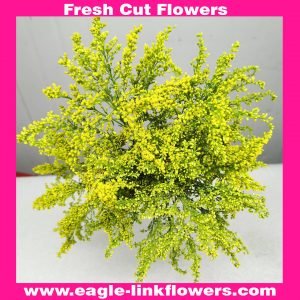
Fillers (73)
-

Agapanthus (2)
-

Amaryllis (2)
-
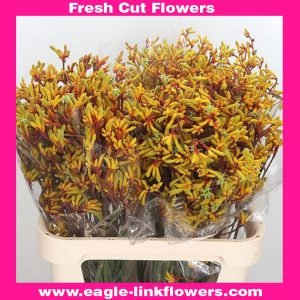
Anigozanthos - Kangaroo Paw (4)
-

Delphiniums (4)
-

Eryngium (3)
-

Eustoma Lisianthus (6)
-

Gypsophila (4)
-

Hydrangea (8)
-
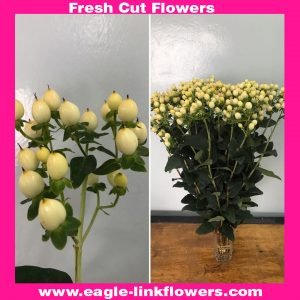
Hypericum (4)
-

Limonium (6)
-

Statice (2)
-

Stocks (Matthiola) (4)
-

Fillers and Foliage (24)
-

Lilies (35)
-

Alstroemeria (8)
-

Asiatic Lilies (6)
-

Calla Lily (8)
-

Florinca - Spray Alstroemeria (7)
-

Oriental Lilies (6)
-

Orchids (11)
-

Cymbidium orchids (7)
-

Dendrobium Orchids (4)
-

Peonies & Tulips (21)
-

Tulips (8)
-

Peonies (13)
-
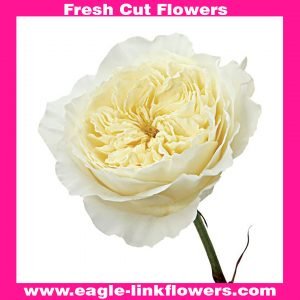
Perfumed Roses (69)
-

David Austin (18)
-

Garden Roses (38)
-

Wabara Garden Roses (Japanesse Varieties) (13)
-

Roses (195)
-

Dyed or Tinted Roses (3)
-

Premium Roses (82)
-

Rose Petals (3)
-

Supermarket Range Roses - Intermediate Roses (62)
-

Sweetheart or Petite Roses (6)
-

T-Hybrid Roses (42)
-

Spray Roses (52)
-

Premium Spray Roses (21)
-

Regular Spray Roses (12)
-

Supermarket Range Spray Roses (5)
-

Tropical Flowers (26)
-

Anthuriums (11)
-

Birds of paradise (1)
-

Gladiolus (9)
-

Ranunculus (4)
-

Sunflower (Helianthus) (1)
-

Clustar Roses (8)
-

Trendsetter (6)
-

Dyed or Tinted Flowers (10)
-

Tinted Gypsophila (7)
 English
English
 French
French
 German
German


